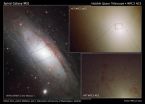Outlook for an industry that touches 96 percent of all manufactured goods
2012-01-13
(Press-News.org) The chemical industry, which touches 96 percent of all manufactured goods, is seeing some positive signs for 2012, although the overall outlook is not very rosy. Growing demand for chemicals used in agriculture, electronics, cars and airplanes will boost an industry that generates $674 billion in sales in the U.S. alone, but expiring patents and global economic woes will take a toll. These forecasts and others are in the cover story in the current issue of Chemical & Engineering News (C&EN), the weekly newsmagazine of the American Chemical Society, the world's largest scientific society.
C&EN points to positive developments for some chemical manufacturers, like Boeing ramping up production of its Dreamliner planes, a boon for makers of high-tech glues and carbon fiber. The article explains U.S. chemical firms will be more competitive globally due to low prices of natural gas and other raw materials and good opportunities for exports. Petrochemical producers are looking past 2012, according to the article, and several companies plan to build new manufacturing plants to take advantage of the growing supply of natural gas in the U.S.
At the same time, the pharmaceutical industry is facing the challenge of expiring patents on some of its most popular drugs, which will allow generic manufacturers to grab profits from big-name companies like AstraZeneca. The story also predicts slowing growth in Asia will hurt a number of chemical industries, especially makers of paint and other construction materials. For chemical makers, the article says, "2012 is likely to be a year to endure rather than enjoy."
INFORMATION:The American Chemical Society is a nonprofit organization chartered by the U.S. Congress. With more than 163,000 members, ACS is the world's largest scientific society and a global leader in providing access to chemistry-related research through its multiple databases, peer-reviewed journals and scientific conferences. Its main offices are in Washington, D.C., and Columbus, Ohio.
To automatically receive news releases from the American Chemical Society contact newsroom@acs.org.
END
ELSE PRESS RELEASES FROM THIS DATE:
2012-01-13
Imagine the following scenarios: a co-worker is spoken to condescendingly, excluded from a meeting, or ignored by a supervisor. How does it make you feel? Do you feel differently depending on whether your co-worker is a man or a woman? According to a new study, workers who witness incivility towards colleagues feel negative emotions – especially when the incivility is aimed at workers of the same sex. The work, by Kathi Miner from Texas A&M University and Angela Eischeid from Buena Vista University, Iowa, is the first to look at the relationship between employees' observations ...
2012-01-13
Astronomers using the partially completed ALMA observatory have found compelling evidence for how star-forming galaxies evolve into 'red and dead' elliptical galaxies, catching a large group of galaxies right in the middle of this change.
For years, astronomers have been developing a picture of galaxy evolution in which mergers between spiral galaxies could explain why nearby large elliptical galaxies have so few young stars. The theoretical picture is chaotic and violent: The merging galaxies knock gas and dust into clumps of rapid star formation, called starbursts, ...
2012-01-13
A better understanding of the universe will be the outgrowth of the discovery of the Higgs boson, according to a team of University of Oklahoma researchers. The team predicts the discovery will lead to supersymmetry or SUSY—an extension of the standard model of particle physics. SUSY predicts new matter states or super partners for each matter particle already accounted for in the standard model. SUSY theory provides an important new step to a better understanding of the universe we live in.
Howard Baer, Homer L. Dodge Professor of High Energy Physics in the OU Department ...
2012-01-13
Tropical Storm Heidi is forecast to make landfall today along the Pilbara coast of Western Australia as warnings pepper the coast. NASA's Aqua satellite passed overhead early in the day and captured a visible image showing Heidi's center still north of the Pilbara coast, while her outer bands continue to bring rainfall and gusty winds to coastal residents.
NASA's Aqua satellite passed over Heidi on January 11, 2012 at 02:30 UTC (Jan. 10 at 10:30 a.m. EST) and the Moderate Resolution Imaging Spectroradiometer captured a visible image of the storm. The image showed that ...
2012-01-13
Peering deep inside the hub of the neighboring Andromeda galaxy, NASA's Hubble Space Telescope has uncovered a large, rare population of hot, bright stars.
Blue is typically an indicator of hot, young stars. In this case, however, the stellar oddities are aging, sun-like stars that have prematurely cast off their outer layers of material, exposing their extremely blue-hot cores.
Astronomers were surprised when they spotted these stars because physical models show that only an unusual type of old star can be as hot and as bright in ultraviolet light.
While Hubble has ...
2012-01-13
A new Hubble Space Telescope image centers on the 100-million-solar-mass black hole at the hub of the neighboring spiral galaxy M31, or the Andromeda galaxy, the only galaxy outside the Milky Way visible to the naked eye and the only other giant galaxy in the local group.
This is the sharpest visible-light image ever made of the nucleus of an external galaxy.
The event horizon, the closest region around the black hole where light can still escape, is too small to be seen, but it lies near the middle of a compact cluster of blue stars at the center of the image. The ...
2012-01-13
It's easy to pick up on the movements that other people make—scratching your head, crossing your legs. But a new study published in Psychological Science, a journal of the Association for Psychological Science, finds that people only feel the urge to mimic each other when they have the same goal.
It's common for people to pick up on each other's movements. "This is the notion that when you're having a conversation with somebody and you don't care where your hands are, and the other person scratches their head, you scratch your head," says Sasha Ondobaka of the Donders ...
2012-01-13
SEATTLE – Among overweight and obese adults, a diet rich in slowly digested carbohydrates, such as whole grains, legumes and other high-fiber foods, significantly reduces markers of inflammation associated with chronic disease, according to a new study by Fred Hutchinson Cancer Research Center. Such a "low-glycemic-load" diet, which does not cause blood-glucose levels to spike, also increases a hormone that helps regulate the metabolism of fat and sugar. These findings are published online ahead of the February print issue of the Journal of Nutrition.
The controlled, ...
2012-01-13
PASADENA, Calif. -- A team of astronomers led by scientists at the California Institute of Technology (Caltech) has discovered the three smallest confirmed planets ever detected outside our solar system. The three planets, which all orbit a single star, are smaller than Earth and appear to be rocky with a solid surface. Until now, astronomers have found at most only four other rocky planets, also called terrestrial planets, around other stars.
The trio of new planets is too close to the central star to be in its habitable zone—the ring-shaped region around a star where ...
2012-01-13
Using NASA's Hubble Space Telescope, astronomers have solved a longstanding mystery on the type of star, or so-called progenitor, which caused a supernova seen in a nearby galaxy. The finding yields new observational data for pinpointing one of several scenarios that trigger such outbursts.
Based on previous observations from ground-based telescopes, astronomers knew the supernova class, called a Type Ia, created a remnant named SNR 0509-67.5, which lies 170,000 light-years away in the Large Magellanic Cloud galaxy.
Theoretically, this kind of supernova explosion is ...
LAST 30 PRESS RELEASES:
[Press-News.org] Outlook for an industry that touches 96 percent of all manufactured goods




